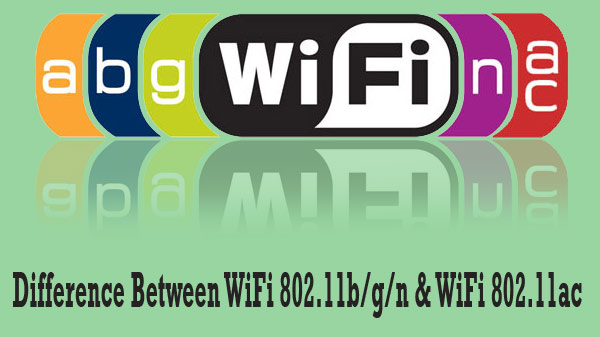Difference between WiFi 802.11 b/g/n vs 802.11ac on Laptops

Nowadays you could see laptops and mobiles comes with different WiFi specification. The latest laptop models all comes with the WiFi 802.11ac. But, you could still find laptops with WiFi 802.11b/g/n. So, here we explained, what is the difference between these standards and what is the advantage of buying a laptop with the latest 802.11ac.
What is 802.11?
It is a standard created by The Institute of Electrical and Electronics Engineers (IEEE). This 802.11 has been created on 1997 the speed of data transfer via this WiFi standard is ver slow. The bandwidth it could handle is only 2Mbps (250KB/Sec). Due to less bandwidth, new standards emerged with high bandwidth and regulated frequencies to avoid interferences.
802.11b ( Year 1999)
- Maximum Theoretical Transfer Rate: 11Mbps (1375 KB/sec)
- Signal Range Indoor: 100 Feet
- Frequency : 2.4GHz Unregulated ( This frequency is used on most of the household appliances like Microwave, Cordless phones, etc., and will cause interference)
802.11a ( Year 1999)
This is not common between home users. It is mostly used in businesses where they could provide much higher bandwidth at shorter distance.
- Maximum Theoretical Transfer Rate: 54Mbps (6750 KB/sec)
- Signal Range Indoor: 50 Feet
- Frequency : 5.15GHz to 5.35GHz Regulated ( Interference from other is eliminated by regulated frequency. However it provides shorter range)
802.11g ( Year 2003)
The most popular with combined benefits of a and b. It operates on 2.4GHz frequency band with 54Mbps of bandwidth.
- Maximum Theoretical Transfer Rate: 54Mbps (6750 KB/sec)
- Signal Range Indoor: 100 Feet
- Frequency : 2.4GHz (Unregulated frequency will get interference from other devices)
802.11n ( Year 2009)
Compatible with 802.11b/g devices.
This standard utilises the multiple antennas and signals to increase the bandwidth intensity. This is called MIMO technology.
- Maximum Theoretical Transfer Rate: 700Mbps (87 MB/sec)
- Signal Range Indoor: 200 Feet
- Frequency : 2.4GHz & 5GHz (Less interference from other devices)
802.11ac ( Year 2013 )
Compatible with 802.11/b/g/n devices.
The latest and popular standard now available in most of the new hardware. It utilises dual band WiFi technology on both 2.4GHz and 5GHz frequency bands.
- Maximum Theoretical Transfer Rate: 400Mbps on 2.4GHz & 800Mbps on 5GHz
- Signal Range Indoor: 100 Feet
- Frequency : 2.4GHz & 5GHz (Interference from 2.4 GHz band devices)
Which one is the best? 802.11b/g/n OR 802.11ac
802.11n supported and 802.11ac supported devices will both serve most of our needs. The only advantage of AC is the Dual Band support. That means, it could use the 2.4GHz band and the 5GHz band at the same time to achieve the maximum bandwidth. Also it is backward compatible.
If you find a laptop with b/g/n support with less price, go for it. It will satisfy most of your purpose. The “802.11ac” will help you only if you transfer huge data like wireless network gaming or HD video streaming from your media center PC to your HD display via WiFi. So, 802.11b/g/n will satisfy most of the laptop users.
Conclusion
802.11b/g/n – For 95% of normal laptop users.
802.11ac – For network gaming and HD video streaming. But still compatible with b/g/n. So, if no huge price difference, go for it.